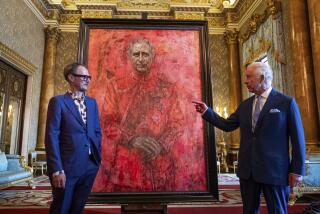New Statue Generates Sizable Controversy in Trafalgar Square
- Share via
LONDON — In the shadow of towering Victorian monuments to British kings and generals and of huge muscled lions, visitors to Trafalgar Square this summer will find a humble, life-size statue of Jesus Christ.
The hairless and beardless Ecce Homo, or “Behold the Man,” was unveiled last week on the edge of a corner plinth that has remained vacant since the square opened more than 150 years ago. It is the first in a series of three sculptures that will occupy the space from now until May 2001.
The controversial Christ figure, by London artist Mark Wallinger, is shocking in its simplicity. He wears nothing but a loincloth and a golden crown of barbed wire. His eyes are closed, as if looking inward; his hands are tied behind his back, and his shoulders are hunched slightly forward. Instead of the agony and grief usually depicted on Christ’s face, this one shows a calm verging on resignation.
But what surprises most people who come to view the statue for the first time is its size. At about 6 feet tall, this Christ is dwarfed by Lord Nelson, England’s greatest naval hero, whose figure stands atop a 168-foot column.
“It’s rather out of proportion,” Glyn Hammond, 54, who traveled 60 miles from Bury St. Edmunds to see the statue, said of the artwork. “It’s a big plinth. You could have had Pontius Pilate and the rest of ‘em behind him.”
The artist responds that people who focus on the scale of the statue miss the point.
This is how Wallinger imagines Christ looking when Pontius Pilate presented him to the jeering crowds before his crucifixion and, according to Christian tradition, before he rose from the dead.
“Jesus was a man. He was a political prisoner in a country ruled by a foreign power,” Wallinger said. “He was a human being in a vulnerable way before stoked-up crowds. I think there are parallels in this century with genocide and religious intolerance.”
Wallinger said that Trafalgar Square, the starting and ending point for many political demonstrations, is an appropriate place for a statue of Christ. And although Wallinger calls himself an agnostic, he felt that Christ was an appropriate spiritual figure for the end of the millennium.
“It doesn’t really matter what religious denomination you are or if you’re an atheist,” Wallinger said. “This is Christ on a human scale. It emphasizes our responsibility as citizens. It is a bit political, a bit spiritual and a bit about kinship with people.”
The three works were selected by the Royal Society of the Arts to generate public debate to help it decide on a permanent exhibit.
And the statue has indeed generated debate.
It may be great for a cathedral, Roy Strong, former director of the Victoria and Albert Museum and of the National Portrait Gallery, wrote in the Daily Mail. But not for Trafalgar Square, which celebrates Britain’s imperial glories.
“Only people totally ignorant of the square’s very definite theme could have chosen something so glaringly inappropriate,” Strong wrote.
But church leaders praised the work as “profoundly moving,” in the words of the Right Rev. Richard Chartres, the Anglican bishop of London. Father Vincent Nichols, the Catholic bishop of Westminster, said he liked its “very human scale.”
The opinion of the Guardian newspaper’s art critic, Fiachra Gibbons, was summed up in a headline: “Behold Jesus, Just Another Ordinary Bloke.”
That is, however, what many people seem to like about the statue. Once recovered from the shock of its size, most said they liked it.
“It’s beautiful,” said Daniel Owers, 25, of London. “It’s just a man on Earth, which is what he was. He looks as if he’s ready to leap into the unknown.”
The statue will be on display until February, when it is to be replaced with a work by Bill Woodrow titled “Regardless of History,” showing a head crushed by a book. Then Rachel Whiteread’s sculpture--an upside-down cast of the plinth itself--will be put in place.
More to Read
The biggest entertainment stories
Get our big stories about Hollywood, film, television, music, arts, culture and more right in your inbox as soon as they publish.
You may occasionally receive promotional content from the Los Angeles Times.










